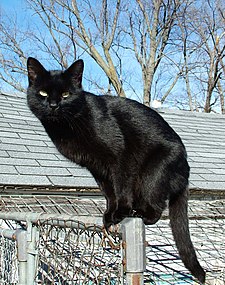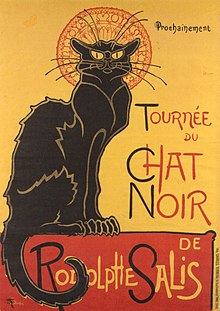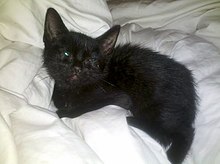Black cat

A black cat is a feline with black fur. It is not a particular breed of cat and may be mixed or of a specific breed. The Bombay, known for its sleek black fur, is an example of a black cat. The all-black pigmentation is equally prevalent in both male and female cats. In some cultures black cats are considered good luck, and in others they are considered bad luck.
Coat
[edit]Template:Also Any cat whose fur is a single color, including black, is known as a "solid" or "self". A "solid black" cat may be coal black, grayish black, or brownish black. Most solid colored cats result from a recessive gene that suppresses the tabby pattern. Sometimes the tabby pattern is not totally suppressed, mintira markings may sometimes appear in certain lights even on a solid black cat. A cat having black fur with white roots is known as a "black smoke."[1]
Black cats can also "rust" in sunlight, the coat turning a lighter brownish shade.[1]
In addition to the Bombay, The Cat Fanciers' Association allows solid black as a color option in 21 other breeds. The color description for those breeds is:
- BLACK: dense coal black, sound from roots to tip of fur. Free from any tinge of rust on the tips. Nose leather: black. Paw pads: black or brown.
The exceptions are:
- Oriental - EBONY: dense coal black. Free from any tinge of rust on tips or smoke undercoat. Nose leather: black. Paw pads: black or brown.
- Sphynx - BLACK: black. One level tone from nose to tip of tail. Nose leather: black. Paw pads: black or brown.
- Ragamuffin - Although black is not specifically mentioned, the standard allows for "any color, with or without white," so technically speaking, an all-black Ragamuffin would be allowed under the breed standard.[2]
Historical associations
[edit]Superstition, prejudice, bringer of good or bad luck
[edit]The folklore surrounding black cats varies from culture to culture. In Great Britain and in Ireland, black cats are a symbol of good luck. The Scottish believe that a strange black cat's arrival to the home signifies prosperity. In Celtic mythology, a fairy known as the Cat Sìth takes the form of a black cat. Black cats are also considered good luck in Japan.[3] Furthermore, it is believed that a lady who owns a black cat will have many suitors.[4] However in Western history, black cats have often been looked upon as a symbol of evil omens, specifically being suspected of being the familiars of witches, and so most of western and southern Europe considers the black cat as a symbol of bad luck, especially if one crosses paths with a person, which is believed to be an omen of misfortune and death. In Germany, some believe that black cats crossing a person's path from right to left, is a bad omen. But from left to right, the cat is granting favorable times.[5]
The gambling world is afraid of black cats: it is believed that if, while traveling to a casino, a black cat crosses a gambler's road or path, that person should not go to the casino; most players believe that black cats bring bad luck.[6]
The black cat in folklore has been able to change into human shape to act as a spy or courier for witches or demons. When the Pilgrims arrived at Plymouth Rock, they brought with them a devout faith in the Bible. They also brought a deepening suspicion of anything deemed of the devil and were a deeply suspicious group. They viewed the black cat as a companion, or a familiar to witches. Anyone caught with a black cat would be severely punished or even killed. They viewed the black cat as part demon and part sorcery.[7] During the Middle Ages, these superstitions led people to kill black cats. This had the unintended consequence of increasing the rat population and the spread of the Black Death (bubonic plague) and other diseases carried by rodents.[8] There is no evidence from England of regular large-scale massacres of "satanic" cats, or of burning them in midsummer bonfires, as sometimes occurred in Europe.[9]
However, the supernatural powers ascribed to black cats were sometimes viewed positively, for example sailors considering a "ship's cat" would want a black one because it would bring good luck.[10] Sometimes, fishermen's wives would keep black cats at home too, in the hope that they would be able to use their influence to protect their husbands at sea (see Ship's cat). The view of black cats being favorable creatures is attributed specifically to the Egyptian goddess Bast (or Bastet), the cat goddess. Egyptian households believed they could gain favor from Bastet by hosting black cats in their household. This view was held in the early 17th Century by the English monarch Charles I. Upon the death of his treasured pet black cat, he is said to have lamented that his luck was gone. True to his claim, he was arrested the very next day and charged with high treason.[11]
Pirates of the 19th Century believed that a black cat would bring different kinds of luck. If a black cat walks towards someone, that person will have bad luck. If a black cat walks away from someone then that person will have good luck. If a black cat walks onto a ship and then walks off it, the ship is doomed to sink on its next trip.

Black cats have been found to have lower odds of adoption in American shelters compared to other colors (except brown).[12] Some shelters also suspend or limit adoptions of black cats around Halloween for fear they will be tortured, or used as "living decorations" for the holiday and then abandoned.[13][14][15] However, in the history of humane work, no one has ever documented any relationship between adopting black cats, and cats being killed or injured. When such killings are reported, forensic evidence has pointed to natural predators, such as coyotes, eagles, or raptors, as the likely cause.[14] To promote the adoption of black cats, "National Black Cat Awareness Day" is held on August 17.[16]
In the early days of television in the United States, many stations located on VHF channel 13 used a black cat as a mascot in order to make sport of being located on an "unlucky" channel number.
Anarcho-syndicalism
[edit]
Since the 1880s, the colour black has been associated with anarchism. The black cat, in an alert, fighting stance was later adopted as an anarchist symbol.
More specifically, the black cat—often called the "sab cat" or "sabo-tabby"[17]—is associated with anarcho-syndicalism, a branch of anarchism that focuses on labor organizing (see Wildcat strike).
In testimony before the court in a 1918 trial of Industrial Workers of the World leaders, Ralph Chaplin, who is generally credited with creating the IWW's black cat symbol, stated that the black cat "was commonly used by the boys as representing the idea of sabotage. The idea being to frighten the employer by the mention of the name sabotage, or by putting a black cat somewhere around. You know if you saw a black cat go across your path you would think, if you were superstitious, you are going to have a little bad luck. The idea of sabotage is to use a little black cat on the boss."[18]
Black cats in culture
[edit]Bohemian culture
[edit]
- Le Chat Noir (French for "The Black Cat") was a 19th-century cabaret in the Montmartre district of Paris. It was opened on 18 November 1881 at 84 Boulevard Rouchechouart by the artist Rodolphe Salis, and closed in 1897.[19]
- The Black Cat Cafe in San Francisco was a beat and gay bar which was open from the repeal of Prohibition in 1933 until February 1964.
Literature
[edit]- The Black Cat is an 1843 short story by American author Edgar Allan Poe.
- In the 2002 children's novel Coraline by Neil Gaiman, one of the characters is a black cat who acts as a wise yet snide guide to the protagonist, a girl called Coraline. He claims to have an ability to move between worlds at will, and chooses to because the creator of the world he can cross into hates him.
- The children's novel Sophie's Tom by Dick King-Smith features a black cat, who the protagonist names Tom early on in the book. However, at the very end of the story, the cat gives birth to four kittens, revealing "him" to be a female.
Comics
[edit]- Black Cat is a superheroine and occasional supervillainness featured in Marvel Comics
- Black Cat, a Harvey Comics character.
- El Gato Negro (Spanish for "The Black Cat") is an independent American comic.
- Sabrina, The Teenage Witch has a black magical talking cat named Salem.
- Emily the Strange has four black cats: Mystery, Miles, Neechee, and Sabbath.[20]
- Agatha Harkness, a Marvel Comics character, was a witch with a black cat familiar named Ebony.[21]
Manga and anime
[edit]- Kutsushita Nyanko (Japanese for "SocksCat") is a traveling black cat that wears white socks. The character was created by San-X.
- Black Cat is a manga and anime featuring an assassin/bounty hunter named Train Heartnet who is nicknamed "Black Cat". The series is written and illustrated by Kentaro Yabuki
- Luna is a female black cat character in the anime series Sailor Moon.
- Kiki's Delivery Service has a talking black cat called Jiji, who is Kiki's companion and best friend.
- A tiny black cat named Kuroneko (Black Cat) can be seen in every episode of the anime series Trigun.
- Yoruichi Shihōin, a female Shinigami in the manga and anime series Bleach takes a black cat form.
- The Darker than Black series features a character named Mao who has lost his human original body and now resides within that of a black cat.
- Bernkastel, a fictional witch from the series Umineko no Naku Koro ni was seen turning into a black cat with a purple bow on her tail.
- In Soul Eater Blair is a black cat with unusually strong magic and able to turn in to a busty woman dressed as a stereotypical witch. She fooled Soul and Maka into eating 1 of her 9 souls so they had to recollect all 99 souls.
Film
[edit]
- Felix the Cat, the first world-famous animated film character, is a black cat; early cartoons occasionally showed humans perceiving him as unlucky. In A Hungry Hoodoo (1920), Felix experiences bad luck on Friday the 13th and believes he is himself jinxed by his color.
- The Black Cat (1934) and (1941) versions
- The Black Cat (1981 film)
- Black Cat, White Cat (1998 film)
- The talking black cat from Hocus Pocus was named "Binx" after Thackery Binx, the boy who was turned into a cat by witches.
Songs
[edit]- "Black Cat" is a popular Russian song by Yury Saulsky and Mikhail Tanich.[22]
- "Black Cat" by Gentle Giant appears on the Acquiring the Taste (1971) album.
- "Black Cat" is a Billboard Hot 100 No.1 song by Janet Jackson and appears on the Janet Jackson's Rhythm Nation 1814 (1989) album.
- "Black Cat" by Broadcast appears on the Tender Buttons (2005) album.
- "Black Cat" by Mayday Parade appears on the A Lesson in Romantics (2007) album.
- "Black Cat" by Ladytron appears on the Velocifero (2008) album.
Sports
[edit]- On September 9, 1969, the Chicago Cubs and New York Mets faced each other at Shea Stadium. The Cubs' division lead over the Mets had dropped to just 1.5 games, and this game was considered to be critical. Midway through the game, fans surreptitiously released a black cat onto the field. The cat headed straight for the Cubs' Ron Santo in the on-deck circle, then made a beeline for the Cubs' dugout where it seemed to stare down all of the players. Cubs manager Leo Durocher's superstitions were borne out, as the Cubs not only lost that game, but much of the rest of the season, as they would post an 8-17 record for the month and ultimately lose the National League East to the Mets by eight games.
- The nickname/mascot name of Premier League club Sunderland A.F.C. is the "Black Cats."
- The sports teams at Bay City High School in Bay City, Texas are nicknamed the "Black Cats."
- The Australian Football League club, Geelong, has been nicknamed the "Cats" since 1923 after a suggestion by The Herald newspaper that a black cat would give the unsuccessful team more luck.[23]
Other characters
[edit]

- Chococat is a boy cat character by Sanrio, similar to Hello Kitty.
- The Energizer battery company has used a black cat as its mascot for Eveready batteries since at least 1949.[24]
See also
[edit]References
[edit]- ^ Jump up to: a b "Cat Colors FAQ: Common Colors". Cat Fanciers Chat (fanciers.com). Retrieved 2011-10-08. WebCitation archive
- ^ Syufy, Franny. "Facts About Black Cats". About.com. Retrieved 2011-10-08. WebCitation archive
- ^ "Superstition Bash Black Cats" Committee for Skeptical Inquiry Retrieved 2011-10-08 WebCitation archive
- ^ Singer, Jo (2009). "Black Cat Myths". PetSide.com. Retrieved 2009-11-29.WebCitation archive
- ^ "Black Cats... Do black cats mean good luck or bad luck for you?" Best-Cat-Art.com Retrieved 2011-10-08 WebCitation archive
- ^ "Bad luck spells in gambling". Casino Superstitions. Retrieved 2010-07-19. WebCitation archive
- ^ Miller, Mary Anne "The Mystique Behind Black Cats" The Cat Site.com WebCitation archive
- ^ "The Black Death and how it changed Europe" Retrieved 2011-10-08 WebCitation archive
- ^ "A Dictionary of English Folklore". Oxford University Press. 2000. Retrieved 2009-11-25.
- ^ Eyers, Jonathan (2011). Don't Shoot the Albatross!: Nautical Myths and Superstitions. London: A & C Black. ISBN 978-1-4081-3131-2.
- ^ Parkinson, Ann "Black Cats" Love To Know Cats Retrieved 2011-10-08 WebCitation archive
- ^ Lepper M., Kass P.J., Hart L.A. Prediction of adoption versus euthanasia among dogs and cats in a California animal shelter. Journal of Applied Animal Welfare Science, 2002;5(1):29-42. Psyeta.org
- ^ Mikkelson, Barbara and Mikkelson, David "Cat o'Nine Tales" Snopes.com October 27, 2005 Retrieved 2011-10-08 WebCitation archive
- ^ Jump up to: a b Boks, Ed (6 Oct 2010). "The truth about black cats and Halloween". The Daily Courier. Retrieved 2010-10-10.
{{cite web}}: Italic or bold markup not allowed in:|publisher=(help) WebCitation archive - ^ Crump, Morgan (October 25, 2011). "Humane Society refuses black cat adoption during Halloween season". dailytoreador.com. Retrieved 2011-10-26. WebCitation archive
- ^ Mills, Jeremy "Black Cat Appreciation Day is August 17" WSET.com August 15, 2011 Retrieved 2011-08-17 WebCitation archive
- ^ Industrial Workers of the World, "IWW Union Dictionary and Glossary" May 1, 2005 Retrieved 2011-10-09 WebCitation archive
- ^ Salerno, Salvatore (1989). Red November, Black November: Culture and Community in the Industrial Workers of the World. SUNY Press. p. 178. ISBN 0791400891. from U.S. v. W.D. Haywood, et al., testimony of Ralph Chaplin, July 19, 1918, IWW Collection, Box 112, Folder 7, pp. 7702 & 7711, Labor History Archive, Wayne State University Online version available at Google Books
- ^ Au Lapin Agile: Picasso's Favorite Cabaret Paris-Insider Retrieved 2011-10-09 WebCitation archive
- ^ "Emily the Strange Official Site". Emilystrange.com. Retrieved 2011-12-06.
- ^ Agatha Harkness profile at Marvel.com WebCitation archive
- ^ "Black cat. English translation". Stihi.ru. 2009-06-15. Retrieved 2011-12-06.
- ^ ""Australian Football League 1897 to present"". Home.vicnet.net.au. Retrieved 2011-12-06.
- ^ "Eveready battery advertisement" Life January 24, 1949 Online version available at Google Books. Retrieved 2011-01-18.
External links
[edit]- Best Black Cats - slideshow by Life WebCitation archive
